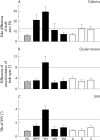Interaction of somatoform and vestibular disorders
- PMID: 16614028
- PMCID: PMC2117464
- DOI: 10.1136/jnnp.2005.072934
Interaction of somatoform and vestibular disorders
Abstract
Background: The high coincidence of organic vestibular and somatoform vertigo syndromes has appeared to support pathogenic models showing a strong linkage between them. It was hypothesised that a persisting vestibular dysfunction causes the development of anxiety disorders.
Objective: To determine the relation between vestibular deficits and somatoform vertigo disorders in an interdisciplinary prospective study.
Methods: Participants were divided into eight diagnostic groups: healthy volunteers (n=26) and patients with benign paroxysmal positioning vertigo (BPPV, n=11), vestibular neuritis (n=11), Menière's disease (n=7), vestibular migraine (n=15), anxiety (n=23), depression (n=12), or somatoform disorders (n=22). Neuro-otological diagnostic procedures included electro-oculography with rotatory and caloric testing, orthoptic examination with measurements of subjective visual vertical (SVV) and ocular torsion, and a neurological examination. Psychosomatic diagnostic procedures comprised interviews and psychometric instruments.
Results: Patients with BPPV (35.3%) and with vestibular neuritis (52.2%) had pathological test values on caloric irrigation (p<0.001). Otolith dysfunction with pathological tilts of SVV and ocular torsion was found only in patients with vestibular neuritis (p<0.001). Patients with Menière's disease, vestibular migraine, and psychiatric disorders showed normal parameters for vestibular testing but pathological values for psychometric measures. There was no correlation between pathological neurological and pathological psychometric parameters.
Conclusions: High anxiety scores are not a result of vestibular deficits or dysfunction. Patients with Menière's disease and vestibular migraine but not vestibular deficits showed the highest psychiatric comorbidity. Thus the course of vertigo syndromes and the possibility of a pre-existing psychopathological personality should be considered pathogenic factors in any linkage between organic and psychometric vertigo syndromes.
Conflict of interest statement
Competing interests: none declared
References
-
- McKenna L, Hallam R S, Hinchcliffe R. The prevalence of psychological disturbance in neurotology outpatients. Clin Otolaryngeol 199116452–456. - PubMed
-
- Clark D B, Leslie M I, Jacob R G. Balance complaints and panic disorder: a clinical study of panic symptoms in members of a self‐help group for balance disorders. J Anxiety Disord 1992647–53.


